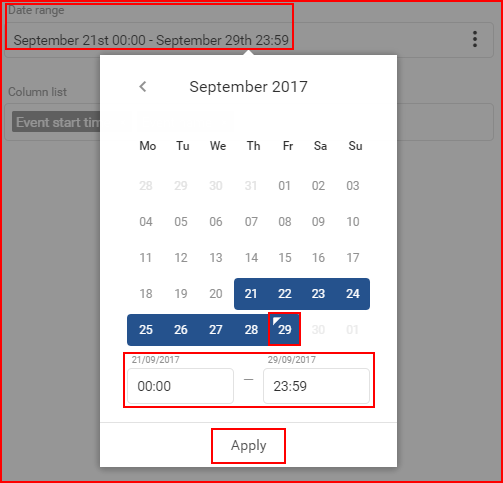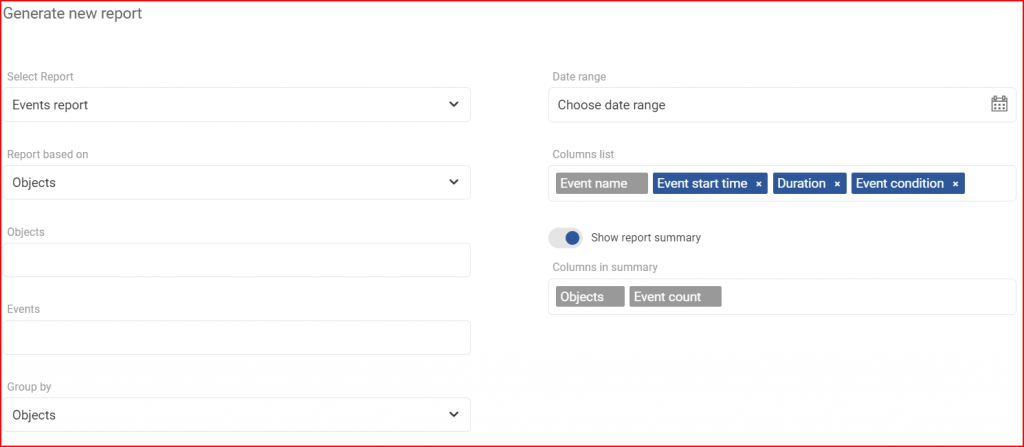Events report – this report type is focused mainly on events, trigger time, duration, and other parameters during the event triggering.
Report based on – this setting defines the main target of the report. There are two available options:
- Drivers
- Objects
What exactly this does is, that the generated report will display information (parameters: trip distance, work begin location, etc.) for the selected target (Drivers or Objects). If Objects are selected, then the report will display information for specifically selected objects.
Objects/Drivers – (Depends on the selection in the “Report based on” option) this allows the user to choose for which objects/drivers the report will be generated.
If Objects are selected, the list will also contain groups of objects. The user can select a whole group by marking the checkbox before the group or click the “+” button to expand the group and see which objects are in the group. To collapse the group, the user must click the “-” button. Individual objects can be selected from a group. It is important to note, if an object that is present in several groups is selected, it will be highlighted in every group as shown below in the picture. If a whole group is selected, the checkbox will be blue with a white tick. If only a part of the group is selected, the group will have a blue square in the checkbox. (shown in the picture below). The user can also use the search, to quickly go through a large list of objects and groups. All groups can be selected/unselected by ticking the checkbox next to “Select all groups”. The number of selected objects and total objects is displayed at the upper right corner of the list.

If Drivers is selected, drivers will be displayed in the drop-down list. To select a driver, the user has to mark the checkbox next to the driver. Marking the checkbox next to “Select all” will select/deselect all drivers. The list is automatically updated with each symbol typed in the search bar. The number of selected drivers and total drivers is displayed at the upper right corner of the list.

After objects or drivers are selected, the user must select how will the report be grouped.
Next, the user can select for which events will this report be generated. This list works the same way as the drivers list. If an event is not selected, it will not be present in the report.
Group by – allows to define by what will the report be grouped, for this report the following selection is available:
- Day – data will be grouped by days
- Events – data will be grouped by events
- Objects – data will be grouped by objects
Date range – to select a date the user must click “Choose date range” which will open the calendar panel. The calendar panel is identical in all of the FMS. To select a begin/end date the user must simply click the desired date and then click the opposite date. The selected days will be highlighted in blue. The current day is highlighted by a small blue triangle on the top left side of that day. If the current day is selected (highlighted), the triangle will be inverted to white. Afterwards, the user can specify from which hour of the begin date until which hour of the end date to display the history. To apply the changes the “Apply” button must be clicked, otherwise, the changes will not be saved.

The minimal date period is one day. To select one day simply double click the left mouse button on the desired day to select it.
After selecting the date range, comes the column list. This report will include the following parameters by default:
- Event name – event title, cannot be unselected
- Event start time – time when the event started, cannot be unselected
- Duration – duration between event start and event end
- Event condition – shows the value, that triggered an event
Other parameters that can be selected additionally:
- Coordinates at end – coordinates of the event end location
- Coordinates at start – coordinates of the event start location
- Driver – driver name
- Event end time – time when the event ended
- Location at end – event end location
- Location at start – event start location
- Mileage at end – mileage at the end of the event
- Mileage at start – mileage at the start of the event
- Object name – name of object
- Trip type – trip type, if defined (business or private)
Finally, the user can select whether to enable the report summary.
Report summary – enabling this option will include a summary section in the report. This will summarize all information in the report (For example, Trips report – contains a long list of all trips. Summary will display a sum for every column such as “working duration”, “Stop duration” etc., as if all the trips were one long trip). This option is disabled by default.

To finalize and generate the report, the user must click the Generate button. To cancel the creation of a report the user must click the Cancel button.
